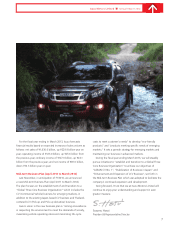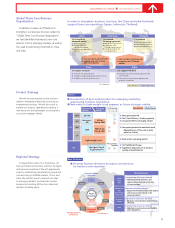Isuzu 2012 Annual Report Download - page 19
Download and view the complete annual report
Please find page 19 of the 2012 Isuzu annual report below. You can navigate through the pages in the report by either clicking on the pages listed below, or by using the keyword search tool below to find specific information within the annual report.
17
Isuzu Motors Limited ■ Annual Report 2012
Sales and model mix fluctuations contributed ¥5.8 billion, while
material cost reductions and fixed cost reduction efforts added
¥11.2 billion and ¥9.2 billion, respectively. Offsetting these were
¥7.4 billion in cost fluctuations (steel, oil prices, etc.) and ¥4.5
billion in exchange rate fluctuations caused by the strength of
the yen. Fixed costs incurred while operations were halted in the
aftermath of the Great East Japan Earthquake during the previous
fiscal year were re-categorized as a special loss, pushing down
operating income by ¥5.1 billion compared to the previous year.
As a result, Isuzu’s operating margin increased to 7.0%,
compared to 6.2% for the previous year.
4. Non-operating gains/losses
In fiscal 2012, Isuzu posted a non-operating gain of ¥5.5 billion,
an improvement of ¥2.4 billion from the previous year.
Equity-method investment income fell ¥2.4 billion from the
previous year to ¥6.1 billion, primarily as a result of the equity-
method affiliate Isuzu Operations (Thailand) Co., Ltd., becoming a
consolidated subsidiary of Isuzu Motors International Operations
(Thailand) Co., Ltd., effective the second quarter of the period
under review.
Reduction of interest-bearing debt resulted in a net interest
(interest and dividends income minus interest expenses) loss of
¥1.1 billion, an improvement of ¥1.9 billion compared to the
previous year. In addition, ¥1.3 billion in compensation expenses
posted last year was returned due to contract changes. This
was augmented by a foreign exchange gain of ¥0.2 billion for a
deterioration of ¥0.1 billion compared to the previous year.
5. Extraordinary gains/losses
In fiscal 2011, Isuzu posted an extraordinary loss of ¥14.5 billion
due to such contributing factors as loss on disposal of noncurrent
assets, impairment loss, environmental expenses and loss due
to disaster. In fiscal 2012, the extraordinary loss improved ¥13.5
billion to ¥1.0 billion, reflecting extraordinary losses including loss
on disposal of noncurrent assets, impairment loss, and loss due to
disaster, and extraordinary income of gain from the sale of fixed
assets, gain on negative goodwill, and gain on step acquisitions.
6. Taxes
Isuzu’s net tax expense in fiscal 2011 including current income
taxes and deferred income taxes was ¥17.2 billion. In fiscal 2012,
the net tax expense was ¥3.7 billion as deferred income taxes
were offset by deferred tax assets.
7. Minority interests
Minority interests consist primarily of profits returned to the
minority shareholders of Isuzu’s locally incorporated subsidiaries
in the ASEAN region and North America and its Japanese parts
manufacturers. Minority interests in fiscal 2012 decreased to ¥6.8
billion, compared to ¥7.8 billion in fiscal 2011.
8. Net income
The Group posted a net profit of ¥91.2 billion in fiscal 2012, an
improvement of ¥39.6 billion from the previous year. Net income
per share came to ¥53.86.
The following provides an analysis of the financial condition and
results of operation in fiscal 2012. The following information
contains forward-looking statements that reflect the judgment of
management as of June 28, 2012.
(1) Significant accounting policies and estimates
The consolidated financial statements of the Isuzu Group
are prepared in accordance with generally accepted accounting
principles of Japan. In the preparation of these statements, the
amounts recorded for items including allowance for doubtful
accounts, inventory, investments, income taxes, retirement
benefits, and provision for product warranties are estimates
that reflect the judgment of management. Due to the uncertain
nature of estimates, in some cases actual results may vary from
initial estimates, and this may have a negative impact on business
results.
(2) Results of operations
1. Overview of fiscal 2012
Despite the impact of flooding in Thailand in October,
continuing improvements to the Company’s cost structure resulted
in sales of ¥1,400 billion (down 1.1% from the previous year),
operating income of ¥97.3 billion (up 10.4% from the previous
year), ordinary income of ¥102.8 billion (up 12.7% from the
previous year), and net income of ¥91.2 billion (up 76.9% from
the previous year).
2. Sales
In fiscal 2012, Isuzu’s consolidated-basis sales declined 1.1%
from the previous year to ¥1,400.0 billion.
In the domestic commercial vehicle market, Isuzu maintained
its high market share through the introduction of products with
superior fuel efficiency and economy, capturing 31.1% of the
medium-duty and heavy-duty trucks market (down 1.7% from the
previous year) and 40.2% of the light-duty (2-3 ton) truck market
(down 0.1% from the pervious year). Demand for medium- and
heavy-duty trucks rose to 59,310 (up 15.4% from the previous
year) and demand for light-duty trucks rose to 65,309 (up 19.9%
from the pervious year) due to reconstruction efforts following
the Great East Japan Earthquake. As a result, domestic sales rose
to ¥558.4 billion (up 12.0% from the previous year).
Sales in Asia fell 13.9% from the previous year to ¥424.0 billion.
Key factors included a decline in shipments due to the effects of
flooding in Thailand in October, and a decrease in overall demand
in the Thai market despite the Group’s high 34% market share in
the country.
North American sales rose 14.8% to ¥72.0 billion, reflecting
growth in demand due to a trend towards recovery in the U.S.
economy.
Sales to other regions declined 4.4% to ¥345.5 billion,
reflecting decreased sales, particularly in Middle East.
3. Operating income
Operating income in fiscal 2012 was ¥97.3 billion, up 10.4%
from a year earlier.
Management’s Discussion and Analysis of Financial Condition and Results of Operation
























